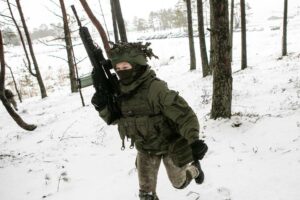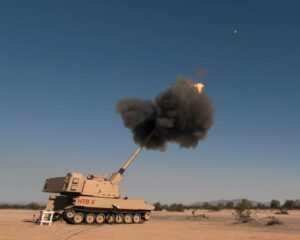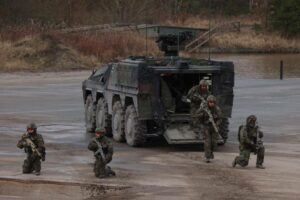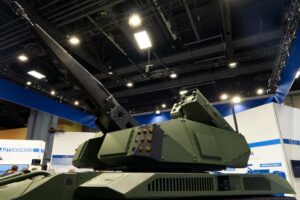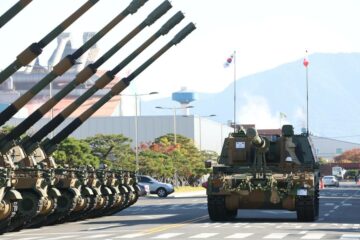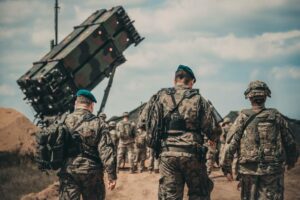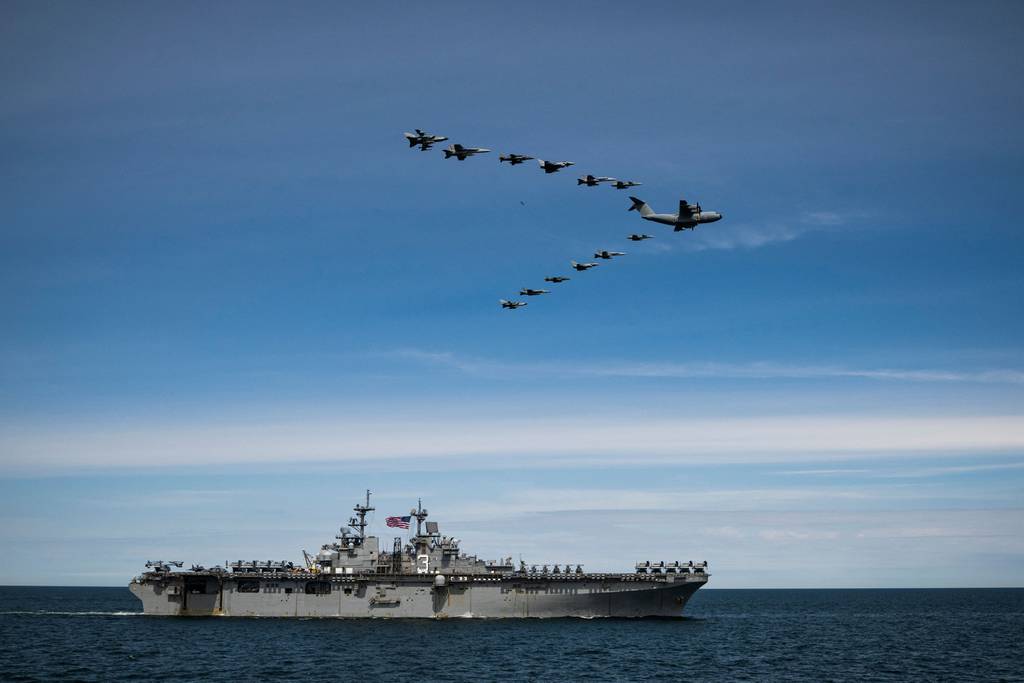
Although the recent NATO summit in Vilnius, Lithuania, was dominated by questions about expanding the alliance, a potentially more consequential shift saw the bloc adopt a new regional defense plan that promises a significantly increased presence — both permanent and rapidly deployable — in Eastern Europe.
What this new plan will look like in practice remains to be seen. But despite the plan’s goal of beefing up NATO’s regional force structure, the coming years offer an opportunity to place the alliance on a firmer and more sustainable footing. This will require a larger European contribution to collective defense, but also a clearer and more efficient division of labor between the U.S. and its allies. Somewhat ironically, the blueprint for such a division is perhaps most clearly seen in a NATO operation that is widely derided and often viewed as a failure.
In 2011, the United States infamously sought to lead from behind as NATO forces intervened in the Libyan civil war. This strategy quickly fell apart as the intervention expanded in scope and extended in duration. With U.S. allies quickly proving incapable of taking on their own leading role in the intervention, Washington ultimately took charge of the operation that toppled Moammar Gadhafi’s regime.
The notion of “leading from behind” has since become, very understandably, a derisive term within the U.S. national security community. Leading from behind, after all, isn’t really leading. And in any event, Europeans proved themselves incapable of taking on a larger role in NATO operations.
Nevertheless, the ongoing war in Ukraine is showing that this concept may be relevant after all, albeit in a very different context from the Libyan operation in which it was first articulated. In particular, the Ukrainian military is proving on a daily basis that U.S. weapons, support and intelligence, when combined with local forces on the ground, can be extremely effective at combating even major military threats in the European theater itself.
The idea of leading from behind implied that the U.S. could provide crucial support at a significant distance from the front lines. The U.S. could contribute intelligence, logistics, command and control, as well as naval and air assets that would enable countries like France and Britain to do much of the grunt work with their own forces and materiel. The U.S. would provide critical support and bear a large share of the cost, but the major risks to service members and expensive platforms would be borne by European allies.
In hindsight, it is clear that Libya was an extremely poor test case for this strategy. The operation required employing force well outside the European theater itself, which was a major problem for European forces. It also relied almost exclusively on air power and long-range, precision-targeted munitions — tools in which the United States has a significant comparative advantage over its allies. In short, the U.S. tried to lead from behind in an operation where its allies were uniquely ill-equipped to lead from the front. Its tarnished reputation, however, belies its potential usefulness in other areas and in other contexts.
In particular, European militaries are far more capable of taking on a front-line role in ground operations on the European continent itself. European troops, armor and artillery — especially when backstopped by American logistics, resupply, intelligence, air power and long-range strike capabilities — are likely to prove quite formidable even against highly capable adversaries.
Importantly, this is precisely the type of operation that would likely be required in the event of any future conflict with Russia. Leading from behind, therefore, might actually be well-suited to the types of threats that are front and center in the minds of NATO defense officials today.
This obviously has important implications for ongoing debates about the proper U.S. military role in Europe. But rather than talking in broad terms about the appropriate size or strength of the U.S. military presence in Europe, we should be talking about what specific capabilities the U.S. should retain, and which it can withdraw.
Ukraine today is demonstrating that even a highly circumscribed role for U.S. military power can make an enormous contribution to continental defense. This is particularly true when that role focuses on capabilities in which the U.S. has asymmetric strengths — e.g., in logistics, intelligence and air power — and is used to complement and supplement local forces that are already deployed in the theater, know the terrain, and are highly motivated to defend their homelands.
In short, the strategy of leading from behind was (rightly) mocked for its failed application in Libya. But this does not mean the strategy itself is inherently flawed. Rather, it was applied in a context for which it was fundamentally ill-suited. In Europe itself, moving forward, the U.S. can and should consider the wisdom of again seeking to lead from behind.
Kyle Haynes is an associate professor of political science at Purdue University and a nonresident fellow at the Defense Priorities think tank.
- SEO Powered Content & PR Distribution. Get Amplified Today.
- PlatoData.Network Vertical Generative Ai. Empower Yourself. Access Here.
- PlatoAiStream. Web3 Intelligence. Knowledge Amplified. Access Here.
- PlatoESG. Automotive / EVs, Carbon, CleanTech, Energy, Environment, Solar, Waste Management. Access Here.
- BlockOffsets. Modernizing Environmental Offset Ownership. Access Here.
- Source: https://www.defensenews.com/opinion/2023/07/25/how-washington-can-lead-from-behind-in-europe/
- :has
- :is
- :not
- :where
- $UP
- 2011
- 70
- a
- About
- actually
- adopt
- ADvantage
- After
- again
- against
- AIR
- All
- Alliance
- already
- also
- American
- an
- and
- any
- apart
- Application
- applied
- appropriate
- ARE
- areas
- AS
- Assets
- Associate
- At
- basis
- BE
- Bear
- become
- behind
- between
- both
- britain
- broad
- but
- by
- CAN
- capabilities
- capable
- case
- Center
- charge
- clear
- clearer
- clearly
- Collective
- combined
- coming
- community
- Complement
- concept
- conflict
- consequential
- Consider
- context
- contexts
- continent
- continental
- contribute
- contribution
- control
- Cost
- could
- countries
- critical
- crucial
- daily
- debates
- Defense
- demonstrating
- deployed
- Despite
- different
- distance
- Division
- do
- does
- duration
- e
- eastern
- eastern europe
- efficient
- enable
- enormous
- especially
- Europe
- European
- Europeans
- Even
- Event
- expanded
- expensive
- extremely
- Failed
- Failure
- far
- fellow
- First
- flawed
- focuses
- For
- Force
- Forces
- formidable
- Forward
- France
- from
- front
- front-line
- fundamentally
- future
- goal
- Ground
- highly
- hindsight
- How
- However
- HTML
- HTTPS
- idea
- images
- implications
- implied
- important
- in
- In other
- incapable
- increased
- inherently
- Intelligence
- intervention
- Ironically
- IT
- ITS
- itself
- jpg
- Know
- labor
- large
- larger
- lead
- leading
- Libya
- like
- likely
- lines
- Lithuania
- local
- logistics
- Look
- look like
- major
- make
- May..
- mean
- Members
- might
- militaries
- Military
- minds
- more
- more efficient
- most
- motivated
- moving
- much
- National
- national security
- New
- Notion
- of
- offer
- officials
- often
- on
- ongoing
- operation
- Operations
- Opportunity
- or
- Other
- outside
- over
- own
- particular
- particularly
- perhaps
- permanent
- Place
- plan
- Platforms
- plato
- Plato Data Intelligence
- PlatoData
- political
- poor
- potential
- potentially
- power
- practice
- precisely
- presence
- Problem
- Professor
- promises
- proper
- Prove
- proved
- provide
- Questions
- quickly
- rapidly
- rather
- really
- recent
- regime
- regional
- relevant
- remains
- reputation
- require
- required
- retain
- risks
- Role
- Russia
- s
- saw
- Science
- scope
- security
- seeking
- seen
- service
- Share
- shift
- Short
- should
- showing
- significant
- significantly
- since
- Size
- somewhat
- sought
- specific
- States
- Strategy
- strength
- strengths
- strike
- structure
- such
- Summit
- supplement
- support
- sustainable
- taking
- talking
- tank
- terms
- test
- than
- that
- The
- Theater
- their
- themselves
- therefore
- think
- think tank
- this
- threats
- to
- today
- took
- tools
- tried
- true
- type
- types
- u.s.
- Ukraine
- Ukrainian
- Ultimately
- Understandably
- uniquely
- United
- United States
- university
- used
- very
- viewed
- war
- War in Ukraine
- was
- washington
- we
- Weapons
- WELL
- were
- What
- when
- which
- widely
- will
- wisdom
- with
- withdraw
- within
- Work
- would
- years
- zephyrnet

